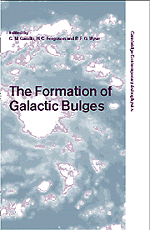Book contents
- Frontmatter
- Contents
- Preface
- Dedication: In Memory of Olin Eggen
- Part 1 Introduction
- Part 2 The Epoch of Bulge Formation
- Part 3 The Timescales of Bulge Formation
- Part 4 Physical Processes in Bulge Formation
- The Role of Bars for Secular Bulge Formation
- Bars and Boxy/Peanut-Shaped Bulges: An Observational Point of View
- Boxy- and Peanut-Shaped Bulges
- A New Class of Bulges
- The Role of Secondary Bars in Bulge Formation
- Radial Transport of Molecular Gas to the Nuclei of Spiral Galaxies
- Dynamical Evolution of Bulge Shapes
- Two-Component Stellar Systems: Phase-Space Constraints
- Central NGC 2146 – A Firehose-Type Bending Instability?
- Bulge Formation: The Role of the Multi-Phase ISM
- Global Evolution of a Self-Gravitating Multi-Phase ISM in the Central Kpc Region of Galaxies
- Part 5 Bulge Phenomenology
- Part 6 Conference Summary
- Index
Boxy- and Peanut-Shaped Bulges
from Part 4 - Physical Processes in Bulge Formation
Published online by Cambridge University Press: 10 November 2010
- Frontmatter
- Contents
- Preface
- Dedication: In Memory of Olin Eggen
- Part 1 Introduction
- Part 2 The Epoch of Bulge Formation
- Part 3 The Timescales of Bulge Formation
- Part 4 Physical Processes in Bulge Formation
- The Role of Bars for Secular Bulge Formation
- Bars and Boxy/Peanut-Shaped Bulges: An Observational Point of View
- Boxy- and Peanut-Shaped Bulges
- A New Class of Bulges
- The Role of Secondary Bars in Bulge Formation
- Radial Transport of Molecular Gas to the Nuclei of Spiral Galaxies
- Dynamical Evolution of Bulge Shapes
- Two-Component Stellar Systems: Phase-Space Constraints
- Central NGC 2146 – A Firehose-Type Bending Instability?
- Bulge Formation: The Role of the Multi-Phase ISM
- Global Evolution of a Self-Gravitating Multi-Phase ISM in the Central Kpc Region of Galaxies
- Part 5 Bulge Phenomenology
- Part 6 Conference Summary
- Index
Summary
Our new statistical study of bulges of disk galaxies reveals a frequency of almost 50% being boxy-or peanut-shaped. Therefore very common processes are required to explain this high fraction. In an analysis of a possible relation between this internal structure and the environment of galaxies with boxy/peanut-shaped bulge we find that on large scales there is no hint for a connection. However, galaxies with boxy- or peanut-shaped bulges have more companions and satellites and show more frequently interactions than a control sample. Thus we conclude that the small-scale environment is important for the existence of such bulges. The most likely reason responsible for the development of boxy/peanut-shaped bulges is a bar originating from galaxy interaction in stable disks or by an infalling satellite.
Introduction
Boxy- and peanut-shaped (hereafter referred to simply as boxy or b/p) bulges are not really as peculiar as it seemed in the past, and very common processes are required to explain their high frequency. At present several mechanisms for their origin are discussed. Binney & Petrou (1985) and Whitmore & Bell (1988) suggest that these structures result from material accreted from infalling satellite companions (soft merging). An alternative mechanism for forming boxy bulges are instabilities or resonances animated by bars (Combes et al. 1990; Raha et al. 1991). N-body simulations for stars in barred potentials have demonstrated that this theory and observational evidence are consistent (in particular from gas kinematics, e.g. Kuijken & Merrifield 1995).
- Type
- Chapter
- Information
- The Formation of Galactic Bulges , pp. 119 - 123Publisher: Cambridge University PressPrint publication year: 2000
- 1
- Cited by



